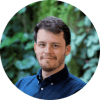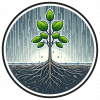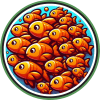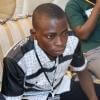About the Series
Starting 10 October, WILDLABS and the Satellite Applications Catapult are proud to announce our new virtual course: Earth Observation 101. This four-part lecture series from Dr Cristian Rossi explores the technologies and the algorithms behind remote sensing and gives an overview of several applications using RS data, including practicalities about data access and processing.
Are you new to Remote Sensing, or want to know more about the applications of the technology? Then this series is for you! This series will give you the practical knowledge base you need to understand the current state of Earth Observation for Conservation and where the field is headed.
Remote Sensing (RS) is the science of obtaining information about the Earth’s physical, chemical, and biological systems without physical contact. It employs sensors that measure the electromagnetic radiation which interacts with land, ocean, and atmosphere. It is used in a diverse set of applications, such as forestry, agriculture, geology, hydrology, archaeology, meteorology, oceanography, zoology, glaciology, and many other disciplines.
RS history dates back over 200 years, with the first photographs capturing landscapes from balloons, kites and even pigeons. Many years later the systematic use of this technology was deployed for surveillance purposes during the two world wars. With rapid scientific progress, the global utilisation of this technology was finally reached in the 70s, with the development of satellites orbiting around the Earth and the establishment of several space agency programmes that provide useful data for research and development. Nowadays, many commercial companies own satellite constellations and the combined data availability from public and private sources is hitting global coverage with hourly acquisitions. This lecture series explores the technologies and the algorithms behind remote sensing and gives an overview of several applications using RS data, including practicalities about data access and processing.
This lecture series is free and allows you to move at your own pace with videos available to all on the WILDLABS YouTube channel. Course content will also be posted in the Earth Observation 101 Community WILDLABS group, where you can navigate through all the content, engage with other participants, and reach out to the course instructor directly.

The Series Schedule
Part 1: How does it work? (10 October)
The first part of the lecture series is focused on exploring the physical fundamentals of the main two earth observation technologies: optical and radar. We will cover the remote sensing process, from data acquisition to result presentation; the main theoretical concept behind remote sensing imaging, i.e. the electromagnetic spectrum; and we finally will explore the basic properties of optical and radar imagery.
Part 2: What can it do? (17 October)
The second part of the lecture series is dedicated to present an overview of many applications where remote sensing data has been used. After a general overview, we will enter more in detail into applications using optical data, with an introduction to vegetation mapping, and finally into radar applications, where we describe the complementarity of these two technologies.
Part 3: How is it being used? (24 October)
The third part of the lecture series covers two specific case studies: an environmental one, i.e. the search for lithium in Cornwall, and a conservation one, i.e. the monitoring of wildlife corridors. The case studies are covered in depth, with a description of the remote sensing process behind them.
Part 4: How do I get started? (31 October)
The last part of the lecture series is the practical one. We will discover how to access earth observation data from both public and commercial providers; we will describe in detail the main public satellite missions; we will discover existing products generated with earth observation data and finally we will briefly describe available tools and platform for data processing.
Meet your course instructor

Dr Cristian Rossi - Satellite Applications Catapult & University of Oxford
Cristian Rossi received the B.Sc. and M.Sc. degrees in telecommunication engineering from the Polytechnic of Milan, Italy and the Ph.D. degree in remote sensing technology from the Technical University of Munich, Germany. He is currently the Geospatial Science Lead at the Satellite Applications Catapult, where he is coordinating with research and academic communities to ensure pull through of science to support organisation activities and he is technically leading several national and international projects focused on the exploitation of remote sensing data for land and ocean applications.
Among his other tasks, Cristian is also responsible of teaching about Earth observation data and algorithms through courses and seminars for industry and academia at all levels and he regularly supports business development and government operations. He is a Visiting Lecturer at the University of Oxford, and he is supervising data science PhD students. He is member of several scientific committees, including UKRI consultations for shaping future research funds, and several Centres for Doctoral Training steering boards. Before moving to the UK, he was a Research Scientist with the German Aerospace Center (DLR), where he was involved in the development of novel algorithms for Earth observation missions. His research interests are focused on data science for sustainable applications and climate change adaptation. He has authored or co-authored more than 90 publications in international journals, conferences, and book chapters.
30 September 2022 3:32pm
Super excited for this!!!
Just to clarify - the dates for each part are just when the videos for that part will be posted? There isn't any specific time it would need to be listened to or whatever?
Also, will there be office hours type sessions like there were for the Build Your Own Datalogger series?
Thanks!

Jake Burton
WILDLABS
Fauna & Flora
3 October 2022 10:01am
In reply to carlybatist
30 September 2022 3:32pm
Super excited for this!!!
Just to clarify - the dates for each part are just when the videos for that part will be posted? There isn't any specific time it would need to be listened to or whatever?
Also, will there be office hours type sessions like there were for the Build Your Own Datalogger series?
Thanks!
@carlybatist the videos will be uploaded to the WILDLABS YouTube channel on those listed dates so you can watch them anytime at your own pace. There is no specific time you need to tune in to view those.
We are considering hosting 'watch parties' for each part of the course though if people from the community group are keen. I will post a discussion in the group later today to see who is interested!

Jake Burton
WILDLABS
Fauna & Flora
5 October 2022 2:13pm
In reply to carlybatist
30 September 2022 3:32pm
Super excited for this!!!
Just to clarify - the dates for each part are just when the videos for that part will be posted? There isn't any specific time it would need to be listened to or whatever?
Also, will there be office hours type sessions like there were for the Build Your Own Datalogger series?
Thanks!
@carlybatist I'm going to try out YouTube premiere for the first part of the course, scheduled for Monday. See here - https://www.youtube.com/watch?v=aoCKZSBuusg
30 September 2022 7:23pm
I'm having issues while registering, after inputting my email, first name and last name, I clicked on register now but it's not loading.

Jake Burton
WILDLABS
Fauna & Flora
3 October 2022 9:45am
In reply to ATM
30 September 2022 7:23pm
I'm having issues while registering, after inputting my email, first name and last name, I clicked on register now but it's not loading.
Sorry to hear you are having issues registering! I have sent you a direct message so I can hopefully sort this out for you.









Carly Batist
WildMon